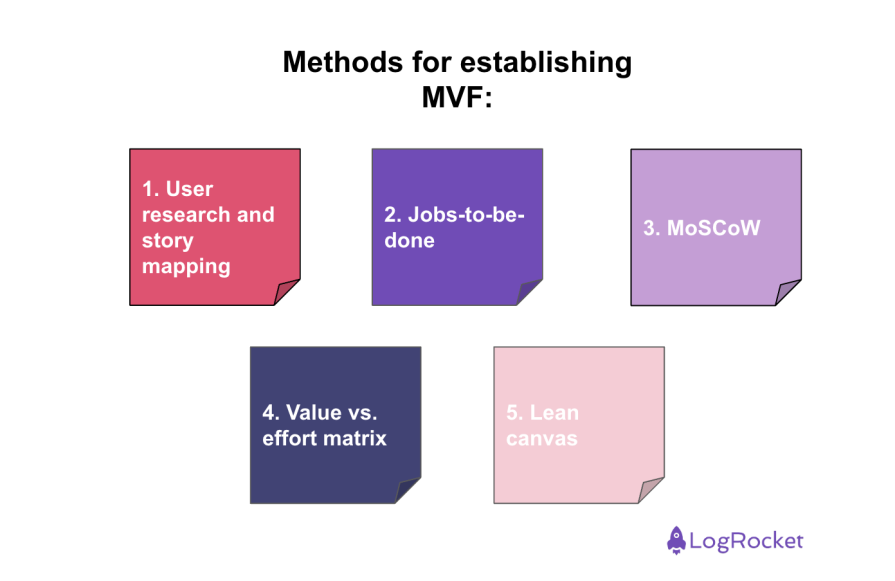In today’s highly competitive software development world, the difference between success and failure often hinges on your ability to identify the right features to prioritize. You need to be able to strike a balance between delivering value and avoiding feature bloat.

Determining your minimum viable features (MVF) helps you achieve this by aligning your product development with customer needs. Keep reading to learn more about the MVF process, how they differ from a minimum viable product (MVP), and how you can implement them within your team.
Minimum viable features (MVF) refer to the set of features necessary to deliver a product that meets the primary needs of your customers, while still providing enough value to be marketable. These deliver maximum value with minimal resources.
Some key characteristics of MVF include:
Identifying your minimum viable features requires a structured approach that combines user research, market and competitive analysis, prioritization techniques, and collaboration among stakeholders. Try use these common methods:

You can conduct user research to understand the problems, needs, and behaviors of your target audience. This could include surveys, interviews, focus groups, and observational studies. Once you gather these insights, create a visual map of your customer’s journey to gain the most value from your product, identify the key steps/features of that journey, and assess what’s absolutely critical to deliver that user experience.
For example, think of an e-commerce website where you provide value to a customer through an easy purchasing process. The MVF could include browsing products, adding items to the cart, checking out, and processing a payment. Other features like advanced filtering, wish lists, and recommendations can be added later.
The JTBD framework helps you understand specific “jobs” how customers try to accomplish them with your product. This approach helps identify the core features you need to complete those “jobs” effectively and quickly.
For example, if you’re developing an online learning platform, the JTBD might include things like “help me learn a new skill,” or “provide practice exercises” as jobs. The MVF would then align with these jobs and include features like bite-sized lessons, quizzes, and progress tracking.
When identifying your list of MVF, you need ways to prioritize them. To help with this, you can use the MoSCoW method:
For example, take a mobile banking app. The must haves would include viewing your account balance and making money transfers. A should have would be bill payments, while a could have would be a personalized budgeting tool. A won’t have feature might be peer-to-peer payments that can be deprioritized for later.
This matrix can help you prioritize features based on their potential value to customers assessed against the effort required to deliver that value. While one axis plots the value provided to your target audience, the other plots the effort required to build and implement the features.
Analyzing the quadrants plotted by the axes, the high value, low effort features are prioritized as the MVF list.
For example, in a SaaS productivity platform, a “Quick Add Task” feature might be identified as high value and low effort, making it a prime candidate for MVF. On the other hand, an integration with a third-party app might be high value, but also high effort, which should then be slated for a future release.
A lean canvas is a tool for mapping out the key aspects of your product, including the primary customer problem, the solution to address that problem, target customer segments, and a unique value proposition. You can create digital templates to implement this tool and get your team members to collaboratively fill them out and analyze the MVF list.
Consider a health and fitness app. A lean canvas would highlight that users struggle with maintaining daily habits. Based on this information, the MVF list could include habit tracking, notifications, and motivational content as the main features to address this problem.
While product managers tend to gravitate towards a MVP, sales teams tend to be more inclined towards MVF. Why? MVF tend to present better revenue opportunities.
A MVP is the most basic version of a product. Sometimes this can make the product difficult to sell. Oftentimes, PMs include MVF in the iterative development process after determining the MVP. To help you understand the differences between the two, consult the following table below:
| Minimum viable features (MVF) | Minimum viable product (MVP) | |
| Definition | Refers to the approach where the absolutely essential features necessary to make a product functional and valuable to its users is worked on | Refers to the strategy where a new product is developed with just enough features to satisfy early adopters and validate the product idea |
| Concept | Emphasizes delivering a product that meets user needs without including unnecessary features, allowing for efficient delivery and early market entry | Typically a fully functioning version of the product, but only contains the most basic features necessary to start the feedback loop with real users |
| Focus | Provide immediate value to users with the feature set | Validate the product idea and learn from users |
| Scope | Narrow scope, with laser focus on a small feature-set that addresses primary user problems | Broader scope, with minimal investment, testing ideas and features that may not be fully formed |
| Purpose | Solve the user’s core problems | Gather user feedback, validate assumptions, test the market, before further development |
| Feedback and iterations | Based on priority and customer feedback. Features are added incrementally | Initial customer feedback is obtained to learn about the users’ needs and market demands |
| Development strategy | Feature-focused and iterative value adds. Prioritization is key | Holistic, albeit basic, testing the entire value proposition |
Successfully implementing MVF involves a strategic and balanced approach of user research, feature prioritization, and cross-functional collaboration. By following industry best practices, you can ensure that you deliver a product that meets core customer needs, aligns with business goals, and lays a strong foundation for future growth.
Here are some best practices you can incorporate:
To show how MVF apply in a real business setting, review these examples of how companies have implemented then to drive product results:
When Spotify was first launched in 2008, the music streaming market was already crowded with big players like iTunes, YouTube, and Pandora. The company needed to differentiate itself while ensuring quick time-to-market.
Spotify’s MVF strategy was focused on providing a seamless music streaming experience with a few critical features — the ability to stream music instantly with minimum buffering, a robust search function that enabled users to find any track, album, or artist, and the ability to create and share playlists. Spotify was able to grow quickly with millions of active users. It later introduced other advanced features that helped further its community of music lovers.
The company was created to address the primary user problem of fragmented communication. It developed a centralized platform for messaging and collaboration, improving team communication and boosting productivity.
Slack’s MVF strategy was focused on a simple, organized way for teams to communicate in channels based on projects or departments, the ability to search through past conversations easily, and the option to share files directly within conversations, reducing the need for external tools. The simplicity of the platform attracted users and helped it to grow globally, quickly. Additional integrations and automations were added later.
Understanding and implementing MVF is crucial for building products that resonate with users, while optimizing resources. By focusing on the essential features that address core customer needs, you can deliver value quickly, gather meaningful feedback, and iterate effectively.
A well-executed MVF strategy can be a significant driver of product success, enabling you to scale and enhance your product offerings over time. Here are the three key takeaways:
Featured image source: IconScout
LogRocket identifies friction points in the user experience so you can make informed decisions about product and design changes that must happen to hit your goals.
With LogRocket, you can understand the scope of the issues affecting your product and prioritize the changes that need to be made. LogRocket simplifies workflows by allowing Engineering, Product, UX, and Design teams to work from the same data as you, eliminating any confusion about what needs to be done.
Get your teams on the same page — try LogRocket today.

Companies don’t agree on the definition of a product manager. However, the essence remains to drive value for customers and the business.

Sowmya Sundararagavan shares best practices for maintaining a strong long-term vision while also remaining flexible.

A feasibility study template is a document that serves as a guide to evaluate whether a project or initiative is practical and worth pursuing.

Julie Swanke talks about the importance of prioritizing intuition and user-friendliness while building internal tools.